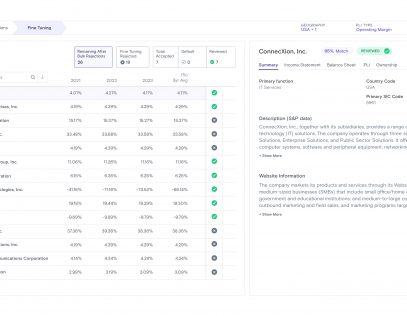Transfer pricing. It’s a term many reporters use to villainize the cross-border activities of multinational companies. But what is it really about?
Transfer prices are the prices charged for goods or services between companies in the same multinational group. These intercompany transactions can involve tangible goods, intangible goods, services, and financing, and there are special transfer pricing rules for each type of transaction.
Tax authorities want to know how those prices are determined. Transfer pricing rules say that a company can’t treat its related companies preferentially. A company has to charge its own entities—or related parties–as it would charge an unrelated company in the open market. In other words, related parties must be charged arm’s-length prices.
Pricing will determine profits–and when profits are crossing borders, so are coveted tax dollars. Each country wants its fair share of taxable income. So, tax authorities want to make sure that multinational groups aren’t manipulating where profits are taxed. That’s why transfer pricing rules were created.
Increasing globalization and growth in trade have given rise to more cross-border transactions over the years–and an increase in tax controversy relating to transfer pricing. It’s one of the most audited areas of tax worldwide, so complying with countries’ transfer pricing rules is crucial to any company that wants to avoid potential audits.
The Guiding Principle – The Arm’s Length Standard
In the U.S. and most other countries, the underlying principle for determining transfer prices between controlled taxpayer is the arm’s- length standard. The arm’s-length standard means that the pricing between related parties must be consistent with the pricing between unrelated parties, had they engaged in the same transaction under the same circumstances. These provisions are contained in Section 482 of the of the U.S. tax code.
Like many other countries, the U.S. tax code takes it even further. It requires the taxpayer to keep documentation proving it charged the market rate to related parties. Companies are also required to show how arm’s-length prices were determined and why those prices meet the arm’s-length standard. If tax authorities believe otherwise, penalties will apply.
The OECD’s Transfer Pricing Guidelines for Multinational Enterprises and Tax Administrations 2017 is the bible of transfer pricing. Tax administrations in countries around the world consider those guidelines when developing their own legislation, as the OECD, an intergovernmental organization with 37 member countries, doesn’t have the authority to legislate on its own. While many countries align their own transfer pricing regulations with the OECD’s guidelines, some countries require additional or different information.
“While many countries align transfer pricing regulations with OECD guidelines, some countries require additional or different information.”
Transfer Pricing Methods
Multinational groups and tax authorities use transfer pricing methods to determine accurate arm’s-length prices. The OECD recommends using “the most appropriate transfer pricing method,” while the U.S. enforces the “the best method rule.” They are one in the same, both mandating that a method should be chosen based on the circumstances of the controlled transaction. While most countries accept OECD-approved methods, many prefer certain methods over others. When tax authorities in a jurisdiction prefer a method, it’s best to use it when possible.
There are two types of transfer pricing methods according to the OECD guidelines: Traditional transactional methods and transactional profit methods.
Traditional Transactional Methods
- Comparable uncontrolled price (CUP) method
- Resale price method (RPM)
- Cost plus (CP) method
Transactional Profit Methods
- Profit-split (PS) method
- Transactional net margin method (TNMM)
Transfer Pricing and Tax Scrutiny
The OECD/G20 base erosion profit shifting (BEPS) initiative launched in 2014. It’s an active ongoing project involving almost 140 jurisdictions to implement 15 measures to reduce tax avoidance and ensure better tax transparency.
The BEPS action plan takes the approach that multinationals have manipulated pricing structures to avoid taxes within the boundaries of the law through tax loopholes–and those loopholes must be eliminated. To help, Action 13 of the BEPS action plan proposes that countries adopt a three-tiered approach to transfer pricing documentation comprised of the master file, the local file, and country-by-country reporting.
The Master File: Provides an overview of an entire organization from a 10,000-foot viewpoint.
The Local File: Examines a company’s operations in a specific country covering all inter-company dealings.
Country-by-Country Reports: Gives high-level visibility into the group’s operations. Involves all of the company’s underlying quantitative data – such as how many employees are located in each jurisdiction? How much profit was taxed? What are the total inter-company transaction amounts?
The Covid-19 pandemic has also added to transfer pricing scrutiny. Market conditions around the world have been affected in different ways, which will make proving arm’s-length conditions that much harder. Like countries, industries have been affected in different ways, too, which means additional challenges in terms of benchmarking.
Governments trying to pull themselves out of an economic recession will naturally look more closely at companies’ transfer pricing to see what extra revenue they can gain. It’s important for a multinational company to document the impact of Covid-19 on their organization and update the economic analysis in their transfer pricing documentation to reflect the current market conditions as it relates to the business.
Transfer Pricing Documentation Requirements
Transfer pricing documentation is the foundation of transfer pricing compliance. Taxpayers must prepare and maintain transfer pricing documentation to demonstrate they have complied with a country’s transfer pricing laws. Tax administrations review transfer pricing documentation to ensure multinational companies haven’t taken advantage of those laws by manipulating their pricing structures.
Documentation can also be an opportunity for a company to tell its story in a proactive way, as it offers many protections. Documentation allows taxpayers to demonstrate adherence to the arm’s-length principle and it can help answer inquiries by tax administrations. Documentation assists with the resolution of transfer pricing disputes; limits accounting disclosures; and can provide some adjustment and penalty protection.
Some countries have formally adopted the OECD guidelines into their transfer pricing documentation requirements. Many others are considering adopting the OECD’s recommendations. Other countries have country-specific requirements, which adds another layer of complexity for multinationals.
U.S. Transfer Pricing Requirements
The U.S. has its own transfer pricing documentation requirements, which differ from OECD guidelines. While the U.S. requires much of the same information that the OECD recommends in the master and local files, it does so in a different format.
The U.S. regulations provide that contemporaneous documentation must contain 10 principal documents. While the U.S. requires the country-by-country report, it does not require the OECD version of the master or local file.
From a U.S. perspective, if a taxpayer prepared a master file and the U.S. local file under OECD guidelines, it would generally meet the U.S. requirement. But the U.S. local file would have to include the specific U.S. transfer pricing methodologies in the economic analysis as well as an index of the 10 principal documents. However, U.S. reports complying with just U.S. transfer pricing documentation requirements would need to be reconciled with OECD guidelines or country-specific regulations (where applicable) to meet the requirements in other countries.
U.S. Best Practices
The IRS issued written guidance in April 2020 clarifying the “best practices” for transfer pricing documentation in the United States. The IRS noticed a decline in the quality of taxpayers’ transfer pricing documentation, and it aimed to encourage multinationals to increase documentation quality.
To avoid penalties, taxpayers should have reasonable and adequate transfer pricing documentation, according to the new advice. Transfer pricing documentation also should be completed promptly and before the tax return is filed.
Taxpayers should also perform a self-assessment for possible areas of noncompliance and proactively make changes to their documentation. The IRS acknowledged it might be hard to find close comparables and that taxpayers should be careful when deciding the comparability of uncontrolled companies and transactions. Taxpayers must include an in-depth analysis of why comparability adjustments were selected, according to the IRS.
A robust and clear analysis of the taxpayer’s operations and related-party transactions must also be included, the IRS said, along with an explanation of the data used, a detailed description of risks faced, and a specification of how profits were allocated among related parties. Adequate documentation is always the way to go. Multinational companies often engage in intercompany transactions. Why are tax authorities watching their every move?
In the intricate terrain of intercompany transfer pricing, adherence to guidelines, meticulous documentation, and awareness of evolving regulations are paramount. As tax authorities intensify scrutiny, multinational companies must navigate the nuances with clarity and precision. Stay compliant, informed, and proactive in your approach to intercompany transfer pricing to safeguard against potential audits and ensure seamless cross-border transactions.









